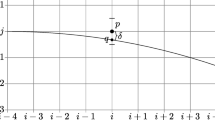Abstract
In this paper a special higher order neuron, the hypersphere neuron, is introduced. By embedding Euclidean space in a conformal space, hyperspheres can be expressed as vectors. The scalar product of points and spheres in conformal space, gives a measure for how far a point lies inside or outside a hypersphere. It will be shown that a hypersphere neuron may be implemented as a perceptron with two bias inputs. By using hyperspheres instead of hyperplanes as decision surfaces, a reduction in computational complexity can be achieved for certain types of problems. Furthermore, it will be shown that Multi-Layer Percerptrons (MLP) based on such neurons are similar to Radial Basis Function (RBF) networks. It is also found that such MLPs can give better results than RBF networks of the same complexity. The abilities of the proposed MLPs are demonstrated on some classical data for neural computing, as well as on real data from a particular computer vision problem.
Access this chapter
Tax calculation will be finalised at checkout
Purchases are for personal use only
Preview
Unable to display preview. Download preview PDF.
Similar content being viewed by others
References
Abu-Mostafa, Y.S.: The Vapnik-Chervonenkis dimension: Information versus complexity in learning. Neural Computation 1(3), 312–317 (1989)
Banarer, V., Perwass, C., Sommer, G.: The hypersphere neuron. In: 11th European Symposium on Artificial Neural Networks, ESANN 2003, Bruges, pp. 469–474. d-side publications, Evere (2003)
Buchholz, S., Sommer, G.: A hyperbolic multilayer perceptron. In: Amari, S.-I., Giles, C.L., Gori, M., Piuri, V. (eds.) International Joint Conference on Neural Networks, IJCNN 2000, Como, Italy, vol. 2, pp. 129–133. IEEE Computer Society Press, Los Alamitos (2000)
Cybenko, G.: Approximation by superposition of a sigmoidal function. Mathematics of Control, Signals and Systems 2, 303–314 (1989)
Fahlman, S.E., Lebiere, C.: The cascade-correlation learning architecture. In: Touretzky, D.S. (ed.) Advances in Neural Information Processing Systems, Denver 1989, vol. 2, pp. 524–532. Morgan Kaufmann, San Mateo (1990)
Fisher, R.A.: The use of multiple measurements in axonomic problems. Annals of Eugenics 7, 179–188 (1936)
Hornik, K.: Approximation capabilities of multilayer feedforward neural networks. Neural Networks 4, 251–257 (1990)
Hoyle, L.: http://www.ku.edu/cwis/units/IPPBR/java/iris/irisglyph.html
Lang, K.J., Witbrock, M.J.: Learning to tell two spirals apart. In: Touretzky, D.S., Hinton, G.E., Sejnowski, T. (eds.) Connectionist Models Summer School, Morgan Kaufmann, San Francisco (1988)
Li, H., Hestenes, D., Rockwood, A.: Generalized homogeneous coordinates for computational geometry. In: Sommer, G. (ed.) Geometric Computing with Clifford Algebra, pp. 27–52. Springer, Heidelberg (2001)
Li, H., Hestenes, D., Rockwood, A.: A universal model for conformal geometries. In: Sommer, G. (ed.) Geometric Computing with Clifford Algebra, pp. 77–118. Springer, Heidelberg (2001)
Lipson, H., Siegelmann, H.T.: Clustering irregular shapes using high-order neurons. Neural Computation 12(10), 2331–2353 (2000)
Minsky, M., Papert, S.: Perceptrons. MIT Press, Cambridge (1969)
Ritter, H.: Self-organising maps in non-Euclidean spaces. In: Oja, E., Kaski, S. (eds.) Kohonen Maps, pp. 97–108. Amer Elsevier, Amsterdam (1999)
Wieland, A., Fahlman, S.E.: (1993), http://www.ibiblio.org/pub/academic/computer-science/neural-networks/programs/bench/two-spirals
Author information
Authors and Affiliations
Editor information
Editors and Affiliations
Rights and permissions
Copyright information
© 2003 Springer-Verlag Berlin Heidelberg
About this paper
Cite this paper
Perwass, C., Banarer, V., Sommer, G. (2003). Spherical Decision Surfaces Using Conformal Modelling. In: Michaelis, B., Krell, G. (eds) Pattern Recognition. DAGM 2003. Lecture Notes in Computer Science, vol 2781. Springer, Berlin, Heidelberg. https://doi.org/10.1007/978-3-540-45243-0_2
Download citation
DOI: https://doi.org/10.1007/978-3-540-45243-0_2
Publisher Name: Springer, Berlin, Heidelberg
Print ISBN: 978-3-540-40861-1
Online ISBN: 978-3-540-45243-0
eBook Packages: Springer Book Archive




